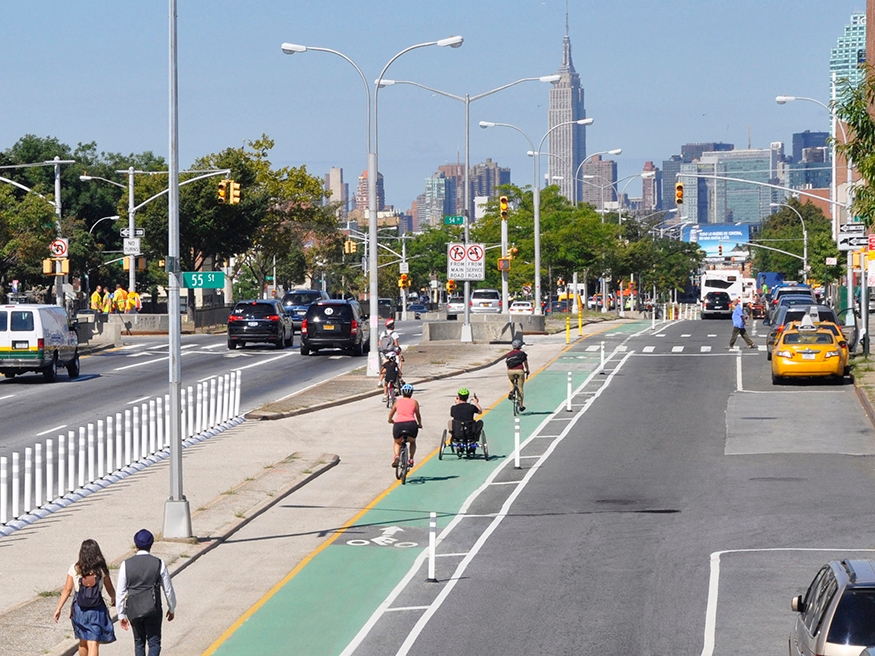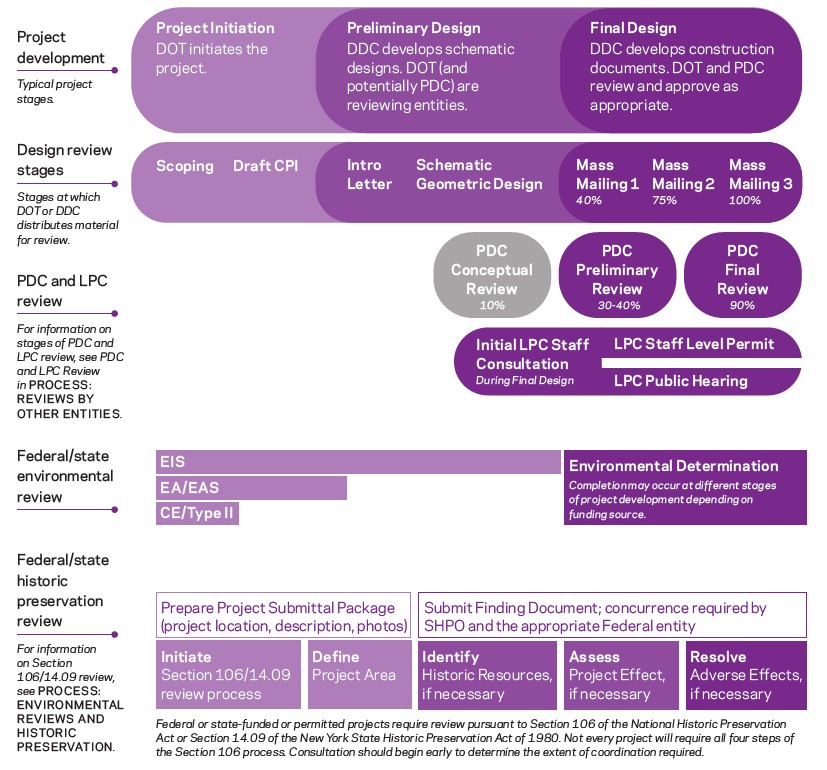
Community Participation
DOT conducts extensive outreach to communities whenever the agency implements safety enhancement projects or makes changes to the local transportation network. Input from residents and businesses helps DOT assess the character and needs of specific neighborhoods in the project-development process. While each DOT unit that manages a project is involved in community outreach, the Borough Commissioners are the agency’s primary liaison with communities and generally conduct the ongoing dialogue.
The Borough Commissioners routinely meet with Community Boards, elected officials, business leaders, and other community stakeholders on issues ranging from full-scale intersection redesign projects to parking regulation adjustments. These meetings can be in community rooms or school auditoriums, in agency or other offices, or on site to review specific traffic concerns.
To facilitate a more robust and inclusive outreach process, DOT’s Street Ambassadors team engages with community members and other street users at project sites and community workshops to better understand mobility and usage patterns and seek input on project elements. The team uses in-person surveys, designed with the project managers, and provides translation services tailored to the neighborhood. The results of these surveys are analyzed to inform project scoping and design choices.
DOT tailors its community outreach to suit the scope, size, complexity, and magnitude of potential impacts of each project. The outreach process is iterative, as DOT often adjusts and modifies projects based on community feedback. For some projects, as with NYC Plaza Program Capital projects, local community institutions may be engaged as maintenance and programming partners. DDC also conducts community outreach for DOT street reconstruction Capital projects, in coordination with DOT. DOT notifies local elected officials of every large project and presents the project to the relevant Community Board(s) during planning and prior to implementation.
DOT Design Reviews and Analyses
Multiple DOT divisions review project designs throughout the planning and design phases. They review designs not only to identify potential problems or conflicts of projects, but also to identify opportunities to advance the agency’s policy goals as enumerated in this Manual, DOT’s strategic plan, and in other DOT publications. Depending on the type of project, DOT divisions consider the following items (some of which overlap with the technical areas addressed by CEQR, the State Environmental Quality Review Act [SEQR], or National Environmental Policy Act [NEPA] processes):
- Safety of all street users
- Pedestrian mobility and access
- Accessibility that meets or exceeds ADA standards
- Cyclist protection and network connectivity
- Transit access and operations
- Network operations
- Pedestrian and vehicular level of service (LOS)
- Air quality
- Construction-phase impacts
- Parking utilization
- Goods delivery
- Community priorities
- Historic resources and neighborhood character
- Public space opportunities
- Resiliency
- Stormwater capture and/or filtration
- Plantings
- Aesthetic appeal
- Temporary and permanent art and street furniture placement
DOT prepares design documents and performs safety and operations analyses as required by federal, state, and local laws, rules, and regulations (including CEQR, SEQR, and NEPA procedures). DOT also conducts its analyses according to standard engineering practices and design guidelines (including those described in this Manual). The level of review varies by project.
Operational & Capital Project Characteristics
| Operational | Capital | |
|---|---|---|
| Elements | Signals, lighting, markings, signs, basic concrete work such as islands or medians, street furniture, landscaping, and paint. No sub-surface or significant drainage work | Project can include full reconstruction, sub-surface infrastructure upgrades and/or relocation, lighting, permanent streetscape elements, regrading, resurfacing, and green infrastructure. Many streetscape elements that can be Expense-funded can also be included in Capital projects. |
| Funding Source | Mostly city Expense funds; some federal and state grants |
Mostly city Capital funds; some federal and state grants |
| Budget | No restrictions | $35,000 minimum ($50,000 minimum as of July 1, 2020) |
| Total Project Timeline | 1–2 years | 4-7 years |
| Coordination with DEP | Generally not necessary | DOT and DEP coordinate to avoid conflict and, where possible, undertake joint projects. DEP requirements may affect implementation schedule. |
| Reviews by Other Agencies* and Utilities | DOT reviews designs with FDNY to confirm emergency vehicle access through new street geometries. Utilities are consulted as necessary. FHWA and NYSDOT review FHWA-funded projects, and FTA reviews projects that it funds. Designs for all works of art and structures† intended for use in a fixed location for more than one year are subject to PDC review.‡ Projects may require LPC and/or SHPO review. | Multiple stakeholders are included in the planning and design review process at DDC, including FDNY, LPC, MOR, NYPD, OMB, Parks, PDC, and SHPO. Private utilities also review. MTA and Port Authority are consulted as necessary. FHWA and NYSDOT review FHWA-funded projects, and the FTA reviews projects that it funds. Coordination with as many as 40 public agencies and private entities may be required. |
| Coordinating Agency | DOT | Typically DDC (in design and construction) |
| Useful Life | No requirements | Minimum 5 years |
| Protected Status | Additional Operational and/or Capital work may often be done at project site post-completion, as needed. | No additional work can be performed at project site for at least 5 years if it damages the Capital asset. |
| Planning | DOT or its consultant | DOT or its consultant |
| Design | DOT or its consultant | DDC or consultant, often based upon a conceptual schematic from DOT |
| Implementation | DOT or its contractor | DDC contractor |
* For major transportation projects, DOT is required to consult with FDNY, NYPD, MOPD, and SBS. Major transportation projects are defined in section 19-101.2 of the New York City Administrative Code as any project that after construction will alter four or more consecutive blocks or 1,000 consecutive feet (whichever is less); a major realignment of the roadway, including either the removal of a vehicular (travel) lane(s) or full-time removal of a parking lane(s) or addition of a vehicular (travel) lane(s). For further information, see Section 19-101.2 of the New York City Administrative Code.
† See the definition of “structures” in Section 854(b) of the New York City Charter.
‡ For further information see Section 854(g) of the New York City Charter.
Reviews by Other Entities
Other city agencies and private utilities regularly review project designs. FDNY reviews any designs—whether Operational or Capital—that might affect its operations. DEP and private utilities review each Capital project for potential impacts on their infrastructure and for opportunities to fold in repair or upgrades of their infrastructure as part of the project.
Aside from FDNY and DEP, other city agencies review DOT projects as necessary. Parks reviews all projects that impact planted areas in the public right-of-way, including greenstreets, existing street trees, or proposed new street trees. NYPD reviews DOT projects that may have security implications. MOPD reviews Operational projects for consistency with ADA standards.
Major transportation projects (as defined in Section 19-101.2 of the New York City Administrative Code) require notification to the affected Community Board(s) and council member(s) as well as consultation with multiple agencies.
See the Operational and Capital Project Characteristics chart higher up on this page for more information on reviews of DOT projects by other entities.
Design Development and Review diagram [PDF]
The Design Development and Review diagram [PDF] describes the sequential development of a project as well as when certain review milestones should occur in the project timeline.
PDC and LPC Review
PDC reviews all projects planned to be installed for more than one year. LPC reviews all projects located within the city-designated historic districts and scenic landmarks or impacting city-designated individual landmarks. Neither Commission reviews or approves roadway markings.
Per Local Law 77 of 1995, the NYC Charter was revised to outline the shared jurisdictions of PDC and LPC with regard to individual landmarks, historic districts, and scenic landmarks depending on project type. In general, PDC has jurisdiction over all art projects and any project not located within a historic district. PDC and LPC have joint jurisdiction over scenic landmarks with projects located in these areas typically requiring review by both Commissions. LPC has jurisdiction over any project occurring within a historic district or impacting an individual landmark, unless it is an artwork. For more information on PDC and LPC jurisdiction and review, visit the PDC and LPC websites.
It is critical for projects to consider reviews by these Commissions and plan accordingly. In general, the Commissions will review projects multiple times throughout design.
Stages of PDC Review
The likelihood of PDC review should be determined during scoping. If PDC review is considered probable, its extent should be determined, and the design team should structure its schedule accordingly.
Conceptual
- Necessary for complex or large-scale projects, including those subject to ULURP
Preliminary
- This is typically the first time PDC reviews the design. Preliminary review is generally an iterative process that may require multiple submissions
- Community Board review is required prior to submission
- All necessary interagency coordination should be accomplished prior to submission
- Maintenance responsibilities must be identified and addressed prior to submission
- Significant design changes after preliminary approval must be submitted for PDC review prior to proceeding to 90% final design
Final
- Conditions of Preliminary approval must be resolved
- Projects—generally those that are narrow in scope—can be submitted for preliminary and final approval simultaneously, provided they comply with all requirements for both levels of review
- All maintenance concerns must be resolved. Outside maintenance partners must commit to responsibilities, as applicable
Stages of LPC Review
Unlike PDC, LPC does not have discrete levels of review; they will issue a report (advisory or binding) upon receipt of appropriate project materials. Consult with LPC staff early to determine the extent of LPC review. Depending on the design, pursuant to LPC's rules, staff may be able to issue an approval. Otherwise, a public hearing will be required followed by a vote from the full Commission. Community Board review is required prior to any hearing.
Environmental Reviews and Historic Preservation
Environmental review processes, NEPA and SEQR/ CEQR, require DOT to assess the potential consequences of its projects. Many of DOT's projects are exempt from review because they fall within a Type II SEQR/CEQR category or are classified as a NEPA Categorical Exclusion (CE). Projects that require federal approval or use federal funding must complete the NEPA process with the federal agency (e.g., FHWA, FTA, FEMA, HUD) in addition to SEQR/CEQR.
Pursuant to Section 106 of the National Historic Preservation Act, if the project uses federal funds or requires federal approvals, the project must be evaluated for its effect on historic properties within what is called the Area of Potential Effect (APE). Section 106 requirements are distinct from those of NEPA, but Section 106 can be coordinated with NEPA. While the federal agency providing the funding is ultimately responsible for making a determination under Section 106, DOT, DDC, or consultants working on their behalf will prepare all relevant project documentation. Projects funded by FHWA are reviewed by NYSDOT for compliance with Section 106 requirements with SHPO providing concurrence on the determination. Projects funded by other federal entities are typically documented by DOT or DDC and reviewed by SHPO. A similar process for evaluation is required under Section 14.09 of the New York State Historic Preservation Act of 1980 for projects using state funds or permits. The team should initiate these processes as early in the project timeline as is possible.
SHPO maintains a searchable and readily available database of historic and cultural resources as well as projects reviewed by their office, the Cultural Resource Information System (CRIS). For additional guidance on city, state, and environmental and historic review, see Resources for resource documents and links.
In addition, for federally funded projects, Section 4(f) of the United States Transportation Act requires FHWA or FTA to make a finding that the project minimizes use of historic resources and parks and recreation areas as defined in the law. This requirement, unlike Section 106, is substantive and contains a specific requirement that the agency select whichever reasonable and prudent alternative minimizes “uses” of those resources.
Design Development and Review diagram [PDF]
The Design Development and Review diagram [PDF] describes the sequential development of a project as well as when certain review milestones should occur in the project timeline.
Projects Initiated Outside DOT
While this chapter focuses on projects that originate at DOT, other entities—both public and private—can plan and design projects that affect the ROW. In such cases, DOT ensures that the projects meet established criteria, particularly with regard to safety, and provides guidance on meeting other requirements and guidelines, such as those enumerated in CEQR and this Manual.
Project designs must conform to existing contexts or, if other, nearby projects are planned, to future conditions. For instance, a project site might be located along an official truck route or a planned bicycle route, in which case DOT requests that sufficient lane widths be maintained to continue to accommodate trucks, or asks that bike lanes be incorporated into the design.


